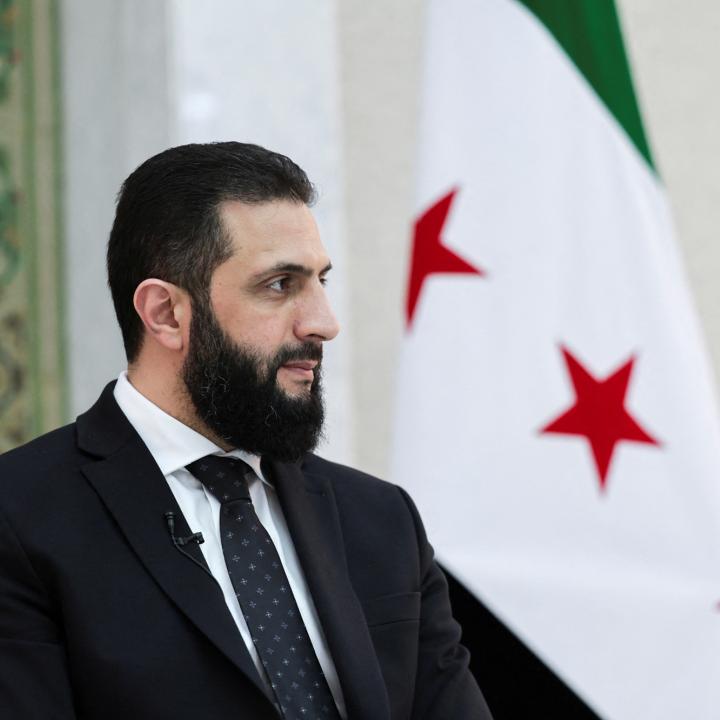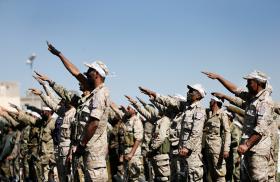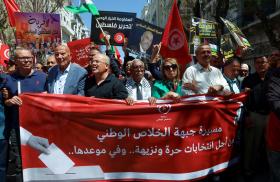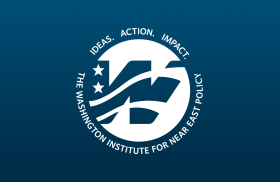
- Policy Analysis
- PolicyWatch 4132
Sharaa on Trump’s Five Points, Six Months On

Damascus has registered clear gains on arresting and deporting Palestinian militants and cooperating against the Islamic State, though its progress on addressing foreign fighters is mixed, and it has stalled on the more politically complex tracks of normalizing with Israel and controlling IS detention facilities.
On November 10, Syrian President Ahmed al‑Sharaa will visit Washington to meet with President Trump and sign onto the eighty-nine‑member Global Coalition to Defeat the Islamic State (IS). In their first meeting in Riyadh on May 14, Trump offered Sharaa a “tremendous opportunity to do something historic in his country,” urging him to address five key points of contention that, if resolved, would pave the way for full restoration of U.S. diplomatic relations, deeper economic ties, and the repeal of longstanding congressional sanctions.
Nearly six months later, progress on each point indicates that Sharaa is addressing most of them, albeit after Washington changed its goalposts on dealing with foreign terrorist fighters who fought alongside him during the civil war. Two outstanding issues—joining the Abraham Accords with Israel and assuming control of IS detention facilities—remain dependent on separate and thus far intractable negotiations: a security agreement between Syria and Israel, and a deal to integrate the Kurdish‑dominated Democratic Autonomous Administration of North and East Syria (DAANES) and Syrian Democratic Forces (SDF). While Sharaa’s scorecard has been good enough to secure a historic meeting in the Oval Office, securing a full repeal of sanctions on Capitol Hill may prove more difficult.
Five Points of Engagement
Since the collapse of the Assad regime last December, Washington has engaged Sharaa’s transitional government with the goal of reorienting a longtime U.S. adversary—backed for decades by Russia and Iran—toward the United States and its regional allies in the Gulf, Turkey, and Israel. Several factors have stood in the way of this reorientation: Sharaa’s past activities fighting American forces; his leadership of Hayat Tahrir al‑Sham (HTS), an al‑Qaeda offshoot and designated terrorist organization; and a slew of sanctions against Syria and the former regime dating back to the country’s inclusion on Washington’s inaugural State Sponsors of Terrorism list in 1979.
This March, the State Department communicated eight questions to the Sharaa government, which Damascus answered in detail. At the Riyadh meeting in May, these points were recast into five:
- Signing onto the Abraham Accords with Israel.
- Telling foreign terrorists to leave Syria.
- Deporting Palestinian terrorists.
- Helping the United States prevent an IS resurgence.
- Assuming responsibility for the detention facilities holding IS fighters, supporters, and family members in the northeast.
Three issues from the original eight‑point list—investigating the fate of missing Americans, including Austin Tice; addressing Syria’s chemical weapons stockpile; and countering the activities of Iran’s Islamic Revolutionary Guard Corps—have reportedly been relegated to other channels.
Progress to Date
Point 3: Deporting Palestinian terrorists. Damascus has made the most progress here. In April, Syrian security forces arrested two Palestinian Islamic Jihad leaders, Khaled Khaled and Yasser al-Zafari; a month later, they arrested Talal Naji, a factional chief with the Popular Front for the Liberation of Palestine-General Command. The PIJ leaders have reportedly left the country, as have other key figures: Khaled Jibril, whose father founded the PFLP‑GC; Khalid Abd al‑Majid, secretary‑general of the Palestinian Popular Struggle Front; and Ziad al-Saghir, secretary-general of Fatah al-Intifada. Yet Syrian sources say Naji and Saghir remain in the country, and all of the men’s whereabouts are unclear—a contentious issue for both the Palestinian Authority and Israel.
Point 4: Helping the United States prevent an IS resurgence. Syrian authorities have clearly intensified their counter‑IS efforts. In January, the Sharaa government thwarted an IS plot to bomb the Shia shrine of Sayyeda Zainab in Damascus, reportedly with the help of U.S. intelligence. In February and March, Syria’s General Security Service arrested Abu al‑Harith al‑Iraqi, a senior leader in the Islamic State’s Iraq “province.” It also broke up IS cells in the Deraa province towns of al‑Naima and Sanamein, followed by other cells in Aleppo and the Damascus countryside. In June, the government announced the arrest of all IS members responsible for bombing the Greek Orthodox Mar Elias Church in Damascus. And in July, authorities arrested IS members in the Idlib countryside.
Meanwhile, U.S. forces directly countered IS in areas under the Sharaa government’s control in July, August, and September. Damascus appears to be actively coordinating with U.S. Central Command against the group, with some accounts noting that it had received U.S. intelligence and participated in eight joint operations with CENTCOM to break up IS cells. This was seemingly confirmed on September 12 when CENTCOM chief Adm. Bradley Cooper met with Sharaa in Damascus and thanked him “for his support to counter [IS] in Syria.” In addition, the U.S.-backed SDF continues to target and arrest IS affiliates.
Point 2: Telling foreign terrorists to leave Syria. The Sharaa government’s record here is mixed, in part due to Washington’s June revision of criteria for how Damascus should address foreign fighters who filled the ranks of HTS and other opposition groups during the civil war. On December 30, Reuters reported that among the fifty fighters appointed by Sharaa and the Ministry of Defense to military roles, six posts had been awarded to foreign Islamist fighters, including Uyghurs, a Jordanian, and a Turk, prompting warnings from the United States, France, and Germany.
In March, Islamist foreign fighters affiliated with the new government made international headlines during an uprising led by former Assad regime elements, reportedly carrying out widespread killings of civilians on the Syrian coast. These incidents led Washington to demand that foreigners be excluded from senior governing roles. Sharaa’s response was measured—noting that his government partly relied on foreign fighters for security, he stated that he would consider granting citizenship to those who had lived in Syria for many years and “stuck beside the revolution.” Indeed, some fighters appear to have stood by Sharaa personally, with Uyghurs apparently serving as his personal security force.
Separately, Damascus noted that the foreign fighter issue “requires a broader consultative session...[W]hat can be confirmed for now is that the issuance of military ranks has been suspended following the earlier announcement regarding the promotion of six individuals.” Yet it did not say whether those ranks had been revoked, nor did it discuss future steps.
In a May 6 press conference with French President Emmanuel Macron, Sharaa stated that foreign fighters had come as individuals, not groups, to support the Syrian people during the revolution, and guaranteed they would not pose a threat to other countries. He added that the forthcoming constitution would specify which foreign fighters and their families are eligible for citizenship.
Damascus and Washington’s approaches appeared to shift after the May 14 Trump‑Sharaa meeting, however. Syrian General Security units in Idlib and Hama reportedly launched a broad campaign targeting foreign fighters of Arab origin (e.g., Palestinians, Egyptians, Tunisians) and others of unknown nationality, all suspected of affiliation with terrorist groups. Yet the Interior Ministry quickly denied the operation. On May 17, Defense Minister Murhaf Abu Qasra issued a warning to small armed groups that had yet to merge with the government’s security apparatus, stating that they must do so within ten days or face unspecified measures. The next day, the East Turkestan Islamic Party—a Uyghur jihadist group allied with al‑Qaeda and present in Afghanistan as well as Syria—joined the ranks of the army.
On June 2, U.S. envoy Tom Barrack indicated that the Trump administration had given its blessing to a new Syrian plan under which “some 3,500 foreign fighters, mainly Uyghurs from China and neighboring countries, would join a newly-formed unit, the 84th Syrian army division, which would also include Syrians.” According to Reuters, when asked “whether Washington approved the integration of foreign fighters into Syria's new military...[Barrack] said: ‘I would say there is an understanding, with transparency.’ He said it was better to keep the fighters, many of whom are ‘very loyal’ to Syria’s new administration, within a state project than to exclude them.”
Since then, this issue has seemingly faded from the Trump administration’s radar, despite reports of foreign fighter involvement in government clashes with Druze militias in July. On Capitol Hill, however, the issue remains active. The Senate version of the National Defense Authorization Act includes a repeal of the 2019 Caesar Act sanctions against the former regime, but also a set of benchmarks for the new government to meet. One of those benchmarks requires the White House to certify that Damascus “has removed, or has taken steps to remove, foreign fighters from senior roles in the Government of Syria, including those in the state and security institutions of Syria.” The bill is currently in conference committee with the House of Representatives.
Outstanding Issues
Point 1: Signing onto the Abraham Accords with Israel. After initially hinting to U.S. Congressman Cory Mills (R-FL) in April that Syria could join the accords “under the right circumstances,” Sharaa has since stated on multiple occasions that the two countries must first address Israel’s occupation of the Golan Heights, its seizures along the border fence line since December, and its ongoing incursions into Syria. He noted that a new Israeli-Syrian security agreement under U.S. mediation would be required to resolve these issues. For its part, Israel is concerned about ensuring safety and humanitarian support for Druze communities in southern Syria, with whom the Sharaa government has clashed repeatedly over the past few months.
Point 5: Assuming responsibility for IS detention facilities. This effort hinges on the U.S.‑mediated discussions over integrating DAANES and the SDF into the new Syrian state and military. It also depends on whether the Trump administration decides to reduce or even completely withdraw U.S. forces from the northeast.
Conclusion
Six months on, Damascus has banked its clearest gains on arresting and deporting some Palestinian militants and cooperating against IS, shown progress on addressing foreign fighters, and stalled on the two most politically complex tracks: normalizing with Israel and assuming control of northeastern detention facilities. Whether Sharaa’s current trajectory yields full U.S. diplomatic normalization and sanctions repeal will depend on three tests in the months ahead:
- Can he reach a baseline security understanding with Israel that addresses the Golan dispute and cross‑border incidents?
- Can Washington midwife a sustainable DAANES and SDF integration plan that avoids sparking new Arab-Kurdish conflict and creates a viable command structure for IS detention operations?
- Will Damascus take credible, durable steps to curtail foreign fighter influence in senior state and security roles?
If those tracks inch forward, next week’s Oval Office optics could translate into sustainable momentum in Congress. If they stall, however, U.S. engagement with Syria’s new government may remain transactional and limited, focused on cooperation against IS and overall detente but eschewing the broader political and economic dividends Sharaa seeks.
Andrew Tabler is the Martin J. Gross Senior Fellow at The Washington Institute. Previously, he served as senior advisor to the U.S. special envoy for Syria and director for Syria at the National Security Council.



